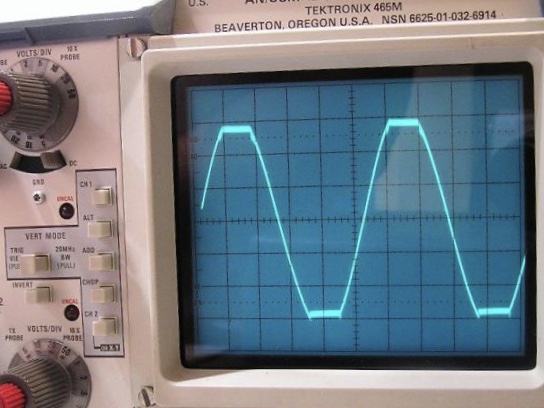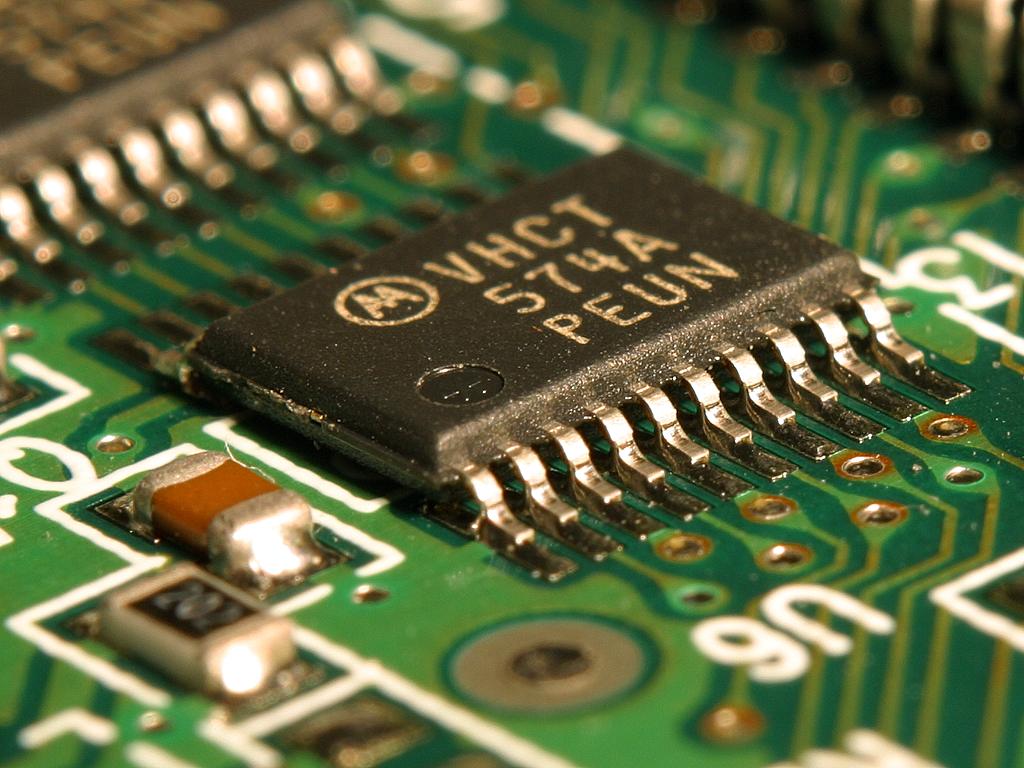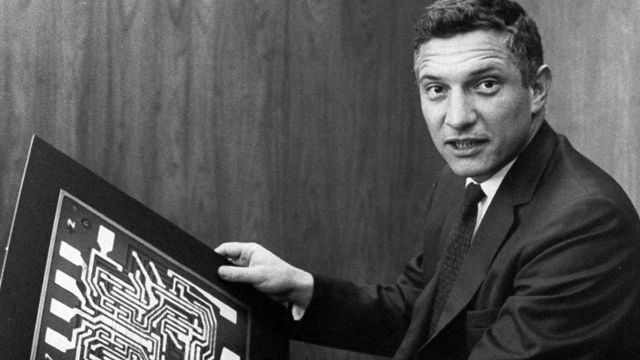|
Clipping (signal Processing)
Clipping is a form of distortion that limits a signal once it exceeds a threshold. Clipping may occur when a signal is recorded by a sensor that has constraints on the range of data it can measure, it can occur when a signal is digitized, or it can occur any other time an analog or digital signal is transformed, particularly in the presence of gain or overshoot and undershoot. Clipping may be described as hard, in cases where the signal is strictly limited at the threshold, producing a flat cutoff; or it may be described as soft, in cases where the clipped signal continues to follow the original at a reduced gain. Hard clipping results in many high-frequency harmonics; soft clipping results in fewer higher-order harmonics and intermodulation distortion components. Audio In the frequency domain, clipping produces strong harmonics in the high-frequency range (as the clipped waveform comes closer to a square wave). The extra high-frequency weighting of the signal could ma ... [...More Info...] [...Related Items...] OR: [Wikipedia] [Google] [Baidu] |
Clipping 1KHz 10V DIV Clip A 5ohms-1-
Clipping may refer to: Words * Clipping (morphology), the formation of a new word by shortening it, e.g. "ad" from "advertisement" * Clipping (phonetics), shortening the articulation of a speech sound, usually a vowel * Clipping (publications), the cutting-out of articles from a paper publication Science and technology * Coin clipping, shaving off a small portion of precious metal for profit * Clipping (computer graphics), only drawing things that will be visible to the viewer * Noclip mode, or "Noclipping", when the player or another object in a video game unrealistically passes through another object * Clipping (gardening), pruning, removing unwanted portions from a plant ** Clippings, the portions that are removed in this process * Clipping (medicine), surgical treatment used to treat an aneurysm * Clipping (signal processing), a form of distortion that limits a signal once it exceeds a threshold. Some forms include: ** Clipping (audio), the clipping of the top and bottom ... [...More Info...] [...Related Items...] OR: [Wikipedia] [Google] [Baidu] |
Oscilloscope
An oscilloscope (formerly known as an oscillograph, informally scope or O-scope) is a type of electronic test instrument that graphically displays varying voltages of one or more signals as a function of time. Their main purpose is capturing information on electrical signals for debugging, analysis, or characterization. The displayed waveform can then be analyzed for properties such as amplitude, frequency, rise time, time interval, distortion, and others. Originally, calculation of these values required manually measuring the waveform against the scales built into the screen of the instrument. Modern digital instruments may calculate and display these properties directly. Oscilloscopes are used in the sciences, engineering, biomedical, automotive and the telecommunications industry. General-purpose instruments are used for maintenance of electronic equipment and laboratory work. Special-purpose oscilloscopes may be used to analyze an automotive ignition system or to display th ... [...More Info...] [...Related Items...] OR: [Wikipedia] [Google] [Baidu] |
Saturation (magnetic)
Seen in some magnetism, magnetic materials, saturation is the state reached when an increase in applied external magnetic field ''H'' cannot increase the magnetization of the material further, so the total magnetic flux density ''B'' more or less levels off. (Though, magnetization continues to increase very slowly with the field due to paramagnetism.) Saturation is a characteristic of ferromagnetism, ferromagnetic and ferrimagnetism, ferrimagnetic materials, such as iron, nickel, cobalt and their alloys. Different ferromagnetic materials have different saturation levels. Description Saturation is most clearly seen in the ''magnetization curve'' (also called ''BH'' curve or hysteresis curve) of a substance, as a bending to the right of the curve (see graph at right). As the ''H'' field increases, the ''B'' field approaches a maximum value asymptote, asymptotically, the saturation level for the substance. Technically, above saturation, the ''B'' field continues increasing, but ... [...More Info...] [...Related Items...] OR: [Wikipedia] [Google] [Baidu] |
Ferromagnetic
Ferromagnetism is a property of certain materials (such as iron) that results in a significant, observable magnetic permeability, and in many cases, a significant magnetic coercivity, allowing the material to form a permanent magnet. Ferromagnetic materials are noticeably attracted to a magnet, which is a consequence of their substantial magnetic permeability. Magnetic permeability describes the induced magnetization of a material due to the presence of an external magnetic field. For example, this temporary magnetization inside a steel plate accounts for the plate's attraction to a magnet. Whether or not that steel plate then acquires permanent magnetization depends on both the strength of the applied field and on the coercivity of that particular piece of steel (which varies with the steel's chemical composition and any heat treatment it may have undergone). In physics, multiple types of material magnetism have been distinguished. Ferromagnetism (along with the similar effec ... [...More Info...] [...Related Items...] OR: [Wikipedia] [Google] [Baidu] |
Transformer
In electrical engineering, a transformer is a passive component that transfers electrical energy from one electrical circuit to another circuit, or multiple Electrical network, circuits. A varying current in any coil of the transformer produces a varying magnetic flux in the transformer's core, which induces a varying electromotive force, electromotive force (EMF) across any other coils wound around the same core. Electrical energy can be transferred between separate coils without a metallic (conductive) connection between the two circuits. Faraday's law of induction, discovered in 1831, describes the induced voltage effect in any coil due to a changing magnetic flux encircled by the coil. Transformers are used to change Alternating current, AC voltage levels, such transformers being termed step-up or step-down type to increase or decrease voltage level, respectively. Transformers can also be used to provide galvanic isolation between circuits as well as to couple stages of signa ... [...More Info...] [...Related Items...] OR: [Wikipedia] [Google] [Baidu] |
Electrons
The electron (, or in nuclear reactions) is a subatomic particle with a negative one elementary charge, elementary electric charge. It is a fundamental particle that comprises the ordinary matter that makes up the universe, along with up quark, up and down quark, down quarks. Electrons are extremely lightweight particles that orbit the positively charged atomic nucleus, nucleus of atoms. Their negative charge is balanced by the positive charge of protons in the nucleus, giving atoms their overall electric charge#Charge neutrality, neutral charge. Ordinary matter is composed of atoms, each consisting of a positively charged nucleus surrounded by a number of orbiting electrons equal to the number of protons. The configuration and energy levels of these orbiting electrons determine the chemical properties of an atom. Electrons are bound to the nucleus to different degrees. The outermost or valence electron, valence electrons are the least tightly bound and are responsible for th ... [...More Info...] [...Related Items...] OR: [Wikipedia] [Google] [Baidu] |
Vacuum Tube
A vacuum tube, electron tube, thermionic valve (British usage), or tube (North America) is a device that controls electric current flow in a high vacuum between electrodes to which an electric voltage, potential difference has been applied. It takes the form of an evacuated tubular envelope of glass or sometimes metal containing electrodes connected to external connection pins. The type known as a thermionic tube or thermionic valve utilizes thermionic emission of electrons from a hot cathode for fundamental Electronics, electronic functions such as signal amplifier, amplification and current Rectifier, rectification. Non-thermionic types such as vacuum phototubes achieve electron emission through the photoelectric effect, and are used for such purposes as the detection of light and measurement of its intensity. In both types the electrons are accelerated from the cathode to the anode by the electric field in the tube. The first, and simplest, vacuum tube, the diode or Flem ... [...More Info...] [...Related Items...] OR: [Wikipedia] [Google] [Baidu] |
Line-level
Line level is the specified strength of an audio signal used to transmit analog sound between audio components such as CD and DVD players, television sets, audio amplifiers, and mixing consoles. Generally, line level signals sit in the middle of the hierarchy of signal levels in audio engineering. There are weaker signals such as those from microphones (Mic Level/Microphone Level) and instrument pickups (Instrument Level), and stronger signals, such as those used to drive headphones and loudspeakers (Speaker Level). The "strength" of these various signals does not necessarily refer to the output voltage of the source device; it also depends on its output impedance and output power capability. Consumer electronic devices concerned with audio (for example sound cards) often have a connector labeled ''line in'' and/or ''line out''. ''Line out'' provides an audio signal output and ''line in'' receives a signal input. The line in/out connections on consumer-oriented audio equipm ... [...More Info...] [...Related Items...] OR: [Wikipedia] [Google] [Baidu] |
Solid State (electronics)
Solid-state electronics are semiconductor electronics: electronic equipment that use semiconductor devices such as transistors, diodes and integrated circuits (ICs). The term is also used as an adjective for devices in which semiconductor electronics that have no moving parts replace devices with moving parts, such as the solid-state relay, in which transistor switches are used in place of a moving-arm electromechanical relay, or the solid-state drive (SSD), a type of semiconductor memory used in computers to replace hard disk drives, which store data on a rotating disk. History The term ''solid-state'' became popular at the beginning of the semiconductor era in the 1960s to distinguish this new technology. A semiconductor device works by controlling an electric current consisting of electrons or electron hole, holes moving within a solid crystalline piece of semiconductor, semiconducting material such as silicon, while the thermionic vacuum tubes it replaced worked by controll ... [...More Info...] [...Related Items...] OR: [Wikipedia] [Google] [Baidu] |
Integrated Circuit
An integrated circuit (IC), also known as a microchip or simply chip, is a set of electronic circuits, consisting of various electronic components (such as transistors, resistors, and capacitors) and their interconnections. These components are etched onto a small, flat piece ("chip") of semiconductor material, usually silicon. Integrated circuits are used in a wide range of electronic devices, including computers, smartphones, and televisions, to perform various functions such as processing and storing information. They have greatly impacted the field of electronics by enabling device miniaturization and enhanced functionality. Integrated circuits are orders of magnitude smaller, faster, and less expensive than those constructed of discrete components, allowing a large transistor count. The IC's mass production capability, reliability, and building-block approach to integrated circuit design have ensured the rapid adoption of standardized ICs in place of designs using discre ... [...More Info...] [...Related Items...] OR: [Wikipedia] [Google] [Baidu] |
Clamper (electronics)
A clamper (or clamping circuit or clamp) is an electronic circuit that fixes either the positive or the negative peak excursions of a signal to a defined voltage by adding a variable positive or negative DC voltage to it. The clamper does not restrict the peak-to-peak excursion of the signal (clipping); it moves the whole signal up or down so as to place its peaks at the reference level. A diode clamp (a simple, common type) consists of a diode, which conducts electric current in only one direction and prevents the signal exceeding the reference value; and a capacitor, which provides a DC offset from the stored charge. The capacitor forms a time constant with a resistor load, which determines the range of frequencies over which the clamper will be effective. General function A clamper will bind the upper or lower extreme of a waveform to a fixed DC voltage level. These circuits are also known as DC voltage restorers. Clampers can be constructed in both positive and negative po ... [...More Info...] [...Related Items...] OR: [Wikipedia] [Google] [Baidu] |
Clipper (electronics)
In electronics, a clipper is a circuit designed to prevent a signal from exceeding a predetermined reference voltage level. A clipper does not distort the remaining part of the applied waveform. Clipping circuits are used to select, for purposes of transmission, that part of a signal waveform which lies above or below the predetermined reference voltage level. Clipping may be achieved either at one level or two levels. A clipper circuit can remove certain portions of an arbitrary waveform near the positive or negative peaks or both. Clipping changes the shape of the waveform and alters its spectral components. A clipping circuit consists of linear elements like resistors and non-linear elements like diodes or transistors, but it does not contain energy-storage elements like capacitors. Clipping circuits are also called ''slicers'' or ''amplitude selectors''. Types Diode clipper A simple diode clipper can be made with a diode and a resistor. This will remove either the po ... [...More Info...] [...Related Items...] OR: [Wikipedia] [Google] [Baidu] |






